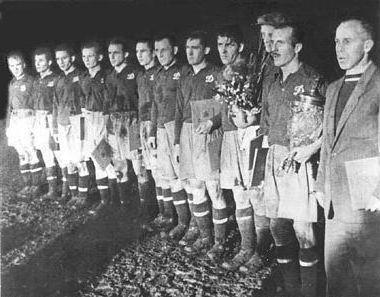The composition of Dynamo (Kiev) has always stood out for its teamwork and professional approach of each player to fulfill their duties. Dynamo players are well aware that they require exclusively winning results in every match, so they try to perform stably.
The composition of Dynamo (Kiev): principles of formation
The emphasis in the formation of the Kiev club has changed several times. In the late 1920s, when the Kiev team held their first matches, only local pupils played in the team. The situation is changing during the preparations for the participation of the team from Kiev in the first USSR football championship. The party and sports leadership of the Ukrainian SSR understood that it was worth paying attention to the leading players from provincial cities. We are talking about Malkhasov, Piontkovsky, Trusevich, Livshits, a pupil of Kharkiv football Fomin, Dnipropetrovsk Laiko and Greber. According to this principle, the people of Kiev formed their composition almost to the end of the history of the USSR.

In the late 1980s, the first legionnaires appeared in Dynamo: Martenkenas, Kvitkauskas, Zweiba. When these people finished their playing career, only Ukrainians played in Dynamo. This continued until 1997. At this time, two Belarusians were transferred from Dynamo Minsk to Kiev, which later became the club's legends. It is about Alexander Khatskevich and Valentin Belkevich.
In the early 2000s, Dynamo focuses on legionnaires from Brazil. In addition, the Nigerians (Yussuf, Okoduva), the Portuguese, the Paraguayans, the French and representatives of other nationalities played for Kiev.
Dynamo lineups (Kiev) by years
Now let's go through the history of the club and see who played at the core of the team in the most important periods. In the opening match of the 1936 USSR Championship against Dynamo Moscow, the Dynamo line-up (Kiev) was as follows: Idzkovsky, Trusevich, Volin, Lifshits, Kuzmenko, Fomin, Tyutchev, Greber, Shilovsky, Parovyshnikov, Shchegodsky, Komarov, Makhinya.
In 1961, Dynamo became the champion of the USSR for the first time. The following players celebrated the victory: Makarov, Klyuyev (goalkeepers), Koltsov, Schegolkov, Shcherbakov, Erokhin, Suchkov, Anufrienko, Pestrikov (defenders), Sabo, Voinov, Sorokin, Biba, Verigin, Turyanchik (midfielders), Serebryannikov, Troyevsky, Bilyannikov, Troyevsky, Troyevsky, Lobanovsky, Kanevsky, Kashtanov, Zaitsev (forwards).
In 1976, when the team won the Cup of Cups, the following athletes played in the composition: Rudakov, Matvienko, Fomenko, Reshko, Onishchenko, Kolotov, Blokhin, Muntyan, Troshkin, Veremeev, Buryak, Konkov, Shepel, Maslov.
1997-1999 is also considered one of the best in the history of the club. A separate page in this story is the match of the 1/2 final of the Champions League 1998/1999 Dynamo - Bayern, which, unfortunately, ended not in favor of Dynamo (Kiev). The composition of the team in this match was as follows: Shovkovsky, Luzhny, Golovko, Vaschuk, Kaladze, Gusin, Khatskevich, Belkevich, Kosovsky, and the legendary Shevchenko-Rebrov pair of forwards. Kiryukhin came out for a replacement.
Who plays in Dynamo sample 2016?
Time passes, and the composition of Dynamo (Kiev) is changing. The leading roles are again played by players with Ukrainian passports. In the 2015/2016 season, 26 players were involved for the team: Shovkovsky, Rybka (goalkeepers), Dragovich, Antunes, Vida, Khacheridi, Silva (defenders), Sidorchuk, Gusev, Makarenko, Yakovenko, Orekhovsky, Garmash, Morozyuk, Belanda, Gonzalez, Buyalsky, Myakushko, Petrovich, Fishing, Veloso (midfielders), Besedin, Yarmolenko, Kravets, Moraes, Teodorchik (forwards).